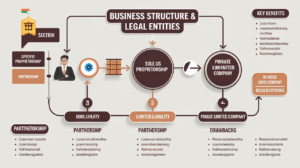Many high school students struggle with uncertainty about their future—a common challenge during the transition to adulthood. This period is often marked by concerns about college affordability, learning environments, and prospective career choices. This article explores the importance of understanding financial aid to make higher education more attainable, compares online and traditional classrooms to help tailor the student’s learning experience, and highlights strategies for identifying career paths that align with a student’s interests and strengths. Keep reading to learn the practical insights and strategies to help students navigate these critical decisions.
Understanding Financial Aid: Making College More Accessible

Guiding high school students toward setting future goals involves a thorough understanding of financial aid, a crucial aspect of making higher education accessible. The landscape of college funding includes scholarships, grants, and loans, which can greatly reduce the financial burden on families and empower students to pursue their academic aspirations.
Financial aid literacy begins with recognizing the variety of available resources, from federal aid to local scholarships, such as those offered by organizations like NSHSS. It’s essential to address common concerns, such as “Is NSHSS scam or not?” The answer is no, as NSHSS is a reputable organization that supports student achievement.
Encouraging students to seek financial aid requires a proactive approach. It’s about diligently meeting application deadlines, ensuring eligibility through academic achievement, and consistently engaging in community service and extracurricular activities.
Detailed awareness and targeted application strategies can facilitate access to financial aid, ultimately contributing to a student’s successful transition from high school to college. By understanding these financial frameworks, students can confidently set their sights on their educational goals, knowing that the means to achieve them are within reach.
Exploring Learning Options: Online vs. Traditional Classrooms
In assisting high school students with setting future goals, they must understand their options for higher education. Traditional classrooms offer the structure and face-to-face interaction many students thrive on, yet an increasing number are finding value in the autonomy and flexibility of online learning. Deciding between these learning formats is critical in planning one’s academic and professional trajectory.
Online education, particularly for programs like a GIS master’s, has gained momentum, catering to learners who juggle various commitments. Such platforms allow students to pursue academic excellence while managing personal and professional responsibilities. It is an adaptable approach to learning, well-suited for the disciplined and self-motivated student. If you’re interested in exploring options, simply search for “GIS masters online” to discover programs that align with your goals.
Conversely, traditional classroom settings provide a more hands-on learning environment and direct access to educators and peer support. These settings encourage immediate feedback and collaborative learning experiences, which are fundamental to some students’ success. The choice of a traditional classroom can foster a sense of community and teamwork that is less tangible in online settings.
Encouraging students to weigh these educational pathways, keeping in mind their individual learning preferences and life circumstances, primes them for making informed decisions. Careful consideration of the pros and cons of online and traditional classrooms will guide them to a conducive environment for their goals and set them on a path to future success.
Identifying Career Paths: Turning Passions into Professions

Early career exploration empowers high school students to align their academic pursuits with their passions, making goal setting for the future practical and motivating. These young individuals benefit from identifying professions that ignite their interests, fostering a commitment to personal and academic growth.
Professional counselors and educational resources in schools should engage students in conversations about the viability of transforming interests into career opportunities. This dialogue encourages students to research and connect with professionals in their fields of interest, cultivating a network that supports their career development.
Strategic planning for post-secondary education equips students with a clear direction for achieving career goals. They learn the importance of selecting appropriate college programs and internships that correspond with their desired professional pathways, ensuring a smoother transition from education to employment.
Parents and educators can reinforce the value of setting measurable and attainable career goals, helping students envision a future where their passions are integrated into rewarding professions. Guidance in this area is vital, as it provides the foundation for students to pursue their aspirations confidently.
Overall, empowering high school students to set goals for their future involves a multifaceted approach that includes understanding financial aid, exploring various learning options, and identifying career paths that resonate with their interests. By providing the right resources and support, parents and educators can help students navigate this critical transition, enabling them to transform their aspirations into achievable realities.








